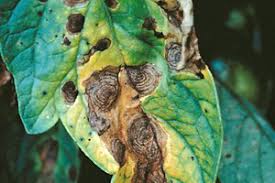Plant Diagnosis
Early Blight of Potato and Tomato Critical
Dark spots on leaves with concentric rings caused by Alternaria solani during June–September.
Description
Early blight is a common and destructive fungal disease caused by Alternaria solani, primarily affecting tomato and potato crops. It typically begins on older, lower leaves as small, dark brown lesions with distinctive concentric rings, resembling a target. These lesions expand, leading to yellowing, premature leaf drop, and reduced plant vigor. Favorable conditions for the disease include warm temperatures (24–29°C) and high humidity, especially following rain or overhead irrigation. Early blight spreads rapidly through wind, water splash, and contaminated tools or debris. If not managed effectively, it can cause significant yield losses—often up to 50%—and compromise fruit quality due to sunscald and reduced foliage cover.
Symptoms
- Brown concentric spots on lower leaves; premature defoliation.


